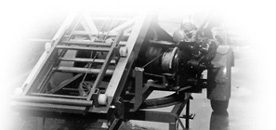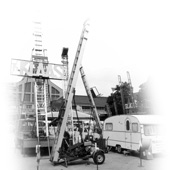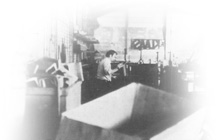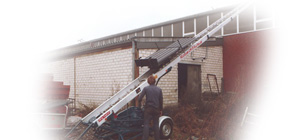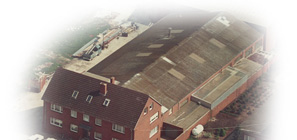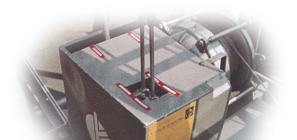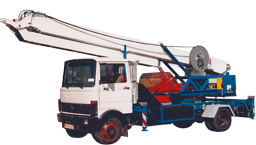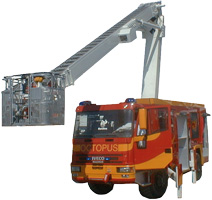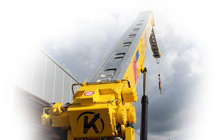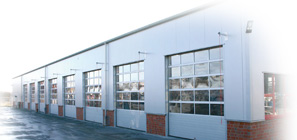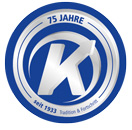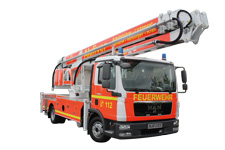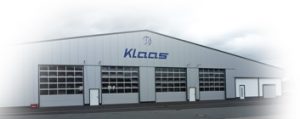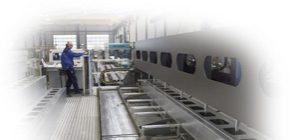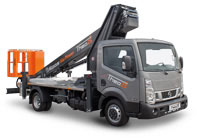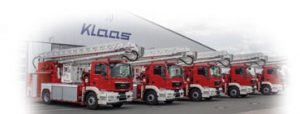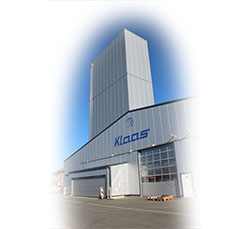1933In 1933 Theodor Klaas, the father of the current company owner, Ludger Klaas, founds his construction company in the Westphalian town of Werne. He mainly constructs large buildings like schools and churches. |
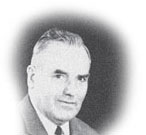 |
|
|
1947From the experience of years of heavy physical work in construction, the idea for the inclined lift is born. Theodor Klaas has this made in Werne out of U-rails with a capacity of 150 l. |
1954On 1 January 1954 Theodor Klaas founds his construction machinery factory and develops his first inclined lift. This is presented with great success at the industrial fair in Hanover in April. |
|
|
|
1962The steadily increasing sales of inclined lifts pushes the production site in Werne to its limits. A new plant is built 17 km away in Ascheberg and the company’s headquarters are relocated there. |
1969After training to become an electrician, Ludger Klaas starts working at his father’s construction machinery factory. Vocational studies and military service leave him little time in the first few years for the company, to which he can fully devote himself again from 1973. |
|
|
|
1972At the start of the 1970s the first inclined lift is made of aluminium with an extension length of 20 m. This is presented to a wide audience at various craft trade fairs. |
1975In order to meet the rising demand for Klaas inclined lifts, the production area is expanded at the Ascheberg plant. |
|
|
|
1978Klaas develops its first hydraulic inclined lift with an extension length of 34 m, thus making a significant mark in the market. |
1980The Ziegelboy roof tile lift developed by Klaas creates a genuine revolution on the roof: the accessory made completely of aluminium saves roofers the arduous task of tile throwing on the roof – and hence time and personnel. |
|
|
|
1990At the start of the 1990s Ludger Klaas starts to develop an aluminium crane. His idea: the quick and labour-saving transport of high loads on the building site and controlling the crane with a class 3 driving licence. |
1993The first aluminium crane is built in this year, thus introducing a new era in the company’s history. The model, set up on a 7.5 t truck, already has a load capacity of 500 kg. |
|
|
|
1994The aluminium crane presented just one year before manages to break into the market, thus ensuring full order books. As the current location has no room for expansion, the production site for aluminium cranes is moved to the opposite side of Raiffeisenstrasse. Klaas Alu-Kranbau GmbH is founded. |
1999Besides the crane construction building, a new production facility for inclined lifts is built. These are continually developed to meet customer needs for more convenience, safety and reliability. |
|
|
|
2000
The company Iveco Magirus is looking for a partner to develop a new height rescue and extinguishing unit for fire engines. Thanks to its many years of experience in the construction of aluminium masts, the choice falls to Klaas. The first step into a new industry – firefighting technology – is thus taken. A test tower is built on the company premises in Ascheberg. |
2003After a three-year development and construction phase, the first Multistar (then still under the name Octopus) is delivered to China. This combination vehicle, the first of its kind worldwide, can be used both for extinguishing fires and saving people. |
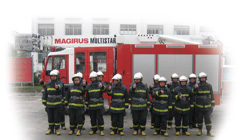 |
|
|
2004Crane sales are booming and the 1,000th Klaas crane leaves the factory. Due to the high demand for Klaas appliances in the new German states, the Gera subsidiary opens in 2004. Things are also happening at the company premises in Ascheberg: the existing garage for vehicles is extended and a separate external warehouse for accessories is built. |
2005Klaas develops a new aluminium mast profile based on TS rails. This means the weight of the mast can be further reduced, while its strength and stability are increased. Klaas Service- und Vertriebs GmbH is founded with Georg Küter being made managing director. |
|
|
|
2007A new service hall is built in Ascheberg for the repair and maintenance of customer appliances. The TS profile, which has proven itself in practical terms, is now also used for the trainer cranes. |
2008The company, which now employs 155 people, celebrates its 75th anniversary on 5 April. |
|
|
|
2009Klaas extends its Germany-wide service network and opens subsidiaries in Tübingen and Wittenberg. |
2010The 2,000th Klaas aluminium crane is sold at the start of the year. In order to be close to customers in the north too, another service and hire station is opened in Hamburg. A new product for fire protection technology is presented to the public: the Klaas AluFiver, a multifunctional elevating rescue vehicle. |
|
|
|
2011The senior management decides to build a new production hall covering 3,000 m², not least to reinforce the Ascheberg site. |
2013A turbulent year: the company celebrates its 80-year anniversary, the delivery of the 3,000th crane and 20th birthday of the aluminium crane. A service and hire station is also opened in the Munich area. In addition the Tübingen subsidiary moves into a new service building at a new site. An innovative welding process is employed: the aluminium booms are produced in the stir welding method from now on, giving the booms even greater strength and stability. Working with the Austrian company, Empl, an industrial firefighting vehicle is developed with a telescopic articulated mast and water gun. |
|
|
|
2014The seventh Klaas service and hire station is opened in autumn. It is located in Bad Nenndorf near Hanover. |
2015The Nuremberg subsidiary is founded as the eighth service station. Klaas adds another product to its range: the Theo25 elevating work platform with a working height of 25 m is launched on the market. |
|
|
|
2016A new office building for service and sales is completed and moved into in May. Five Klaas AluFiver models are produced at the same time and delivered to Hanoi, the capital of Vietnam. Almost at the same time, four new mobile cranes – three of which feature a hydraulic, telescopic fly jib – are launched on the market. New, memorable crane names are introduced with the new models. |
2017The first Klaas crane with hybrid drive is built: a K27-32 RH. It can either be operated with an electric engine or using an auxiliary drive belonging to the truck engine. Two more new appliances are coming onto the market: the Theo20, an elevating work platform with a working height of 20 m, plus the K850 RS, a mobile crane with a hook height of nearly 37 m. Investment in the Ascheberg site: A new high-bay warehouse is being constructed. Up to 180 tonnes of aluminium can be stored in the 24.5-metre high tower – enough material for around 50 cranes. In Kirchheimbolanden a plot of land measuring 3,300 sqm is being purchased. A new Klaas subsidiary for the Rhine-Main/Rhine-Neckar region is expected to be developed here. |
|


